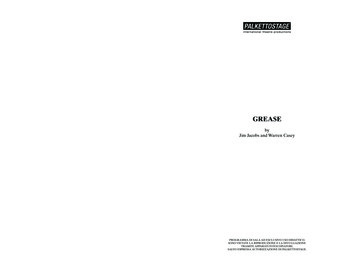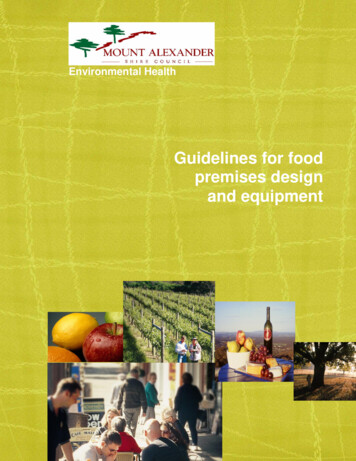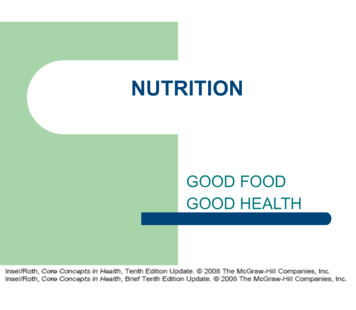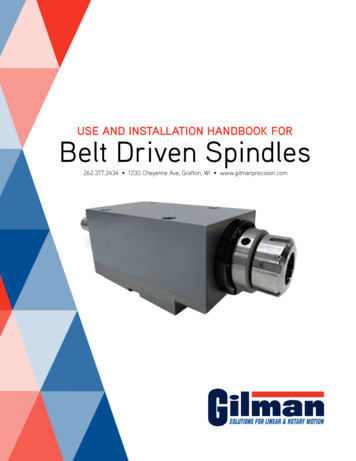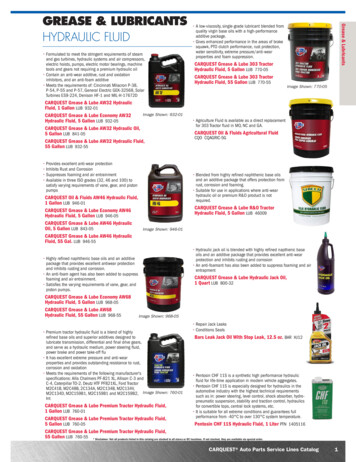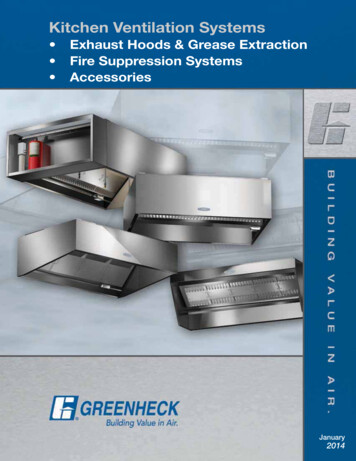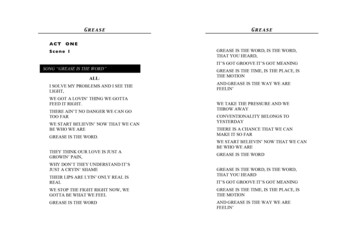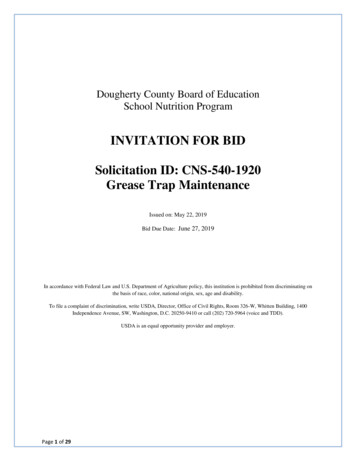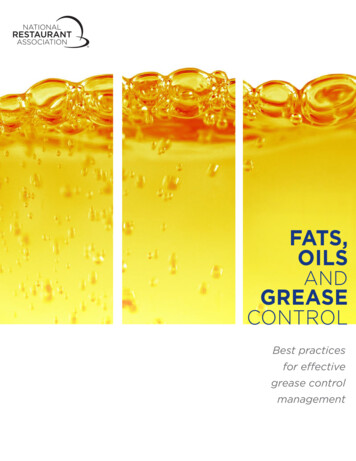
Transcription
GREASE MANAGEMENT PROGRAM HANDBOOK(FATS, OILS, AND GREASE MANAGEMENT)JULY 21, 2021PREPARED BY:ARNETT ENVIRONMENTAL, LLC1038 LAKE SUMTER LANDINGTHE VILLAGES, FL 32162352-753-4747
VILLAGE CENTER COMMUNITY DEVELOPMENT DISTRICT ANDNORTH SUMTER COUNTY UTILITY DEPENDENT DISTRICTGREASE MANAGEMENT PROGRAM HANDBOOKJULY 21, 2021INTRODUCTION . 3GREASE MANAGEMENT PROGRAM CONTACTS . 3STATEMENT OF PURPOSE . 4A. POLICIES CONCERNING FOG REMOVAL DEVICES AND OPERATION . 4B. DESIGN AND CAPACITY . 6C. GENERAL RULES OF PUMPING AND MAINTENANCE . 6D. INTERCEPTORS, SCHEDULE OF PUMPING AND UPGRADES . 7E. INTERCEPTORS, SCHEDULE OF DEEP CLEANING . 8F. GREASE TRAPS, SCHEDULE OF CLEANING . 8G. DISPOSAL AND REMOVAL OF SOLIDS AND WASTE . 8H. RECORDKEEPING AND REPORTING . 8I. NON-COMPLIANCE . 9J. REDUCED PUMPING FREQUENCY (VARIANCE REQUEST) . 10K. BEST MANAGEMENT PRACTICES . 11L. QUESTIONS . 12M. DEFINITIONS . 12APPENDIX A - INFORMATIONAL SIGNS . 13NO GREASE SIGN NO. 1 . 14NO GREASE SIGN NO. 2 . 15APPENDIX B – FORMS & LOGS . 16DISTRICT APPROVED TRACKING FORM . 17FATS, OILS, AND GREASE WASTE DISPOSAL MANIFEST EXAMPLE . 18GREASE TRAP CLEANING AND MAINTENANCE REPORT . 19REDUCED PUMPING FREQUENCY FORM (VARIANCE REQUEST) . 20FATS, OILS, AND GREASE REMOVAL DEVICE PROGRAM REGISTRATION FORM . 212
INTRODUCTIONFats, oils, and grease (FOG) is a major concern for wastewater collection systems. When not disposedof properly, FOG forms thick layers inside sewers constricting flow, similar to the way cholesterol affectsblood flow in our arteries. Clogged sewers require additional maintenance and cleaning and can result insewage spills and overflows. FOG also places additional loadings on wastewater treatment plants, whichcan result in process operational difficulties, added treatment costs, and possible plant upsets.Restaurants are a significant source of FOG because of the amount of grease used in cooking and otherfood prep work. Improper cleanup practices allow food particles, oil, grease, and cleaning products toflow to the sanitary sewer.Utility operation contractors devote many pieces of equipment and man hours to unstopping and cleaningsanitary sewer collection systems which include, but not limited to, manholes, lift stations, gravity lines,and service lines clogged with oil and grease.This Handbook maintains the discharge limitation for oil and grease at 250 mg/L (milligrams per liter) forusers of the wastewater collection systems within The Villages. Additionally, the Handbook requiresusers to install and maintain a FOG removal device at their facility.All facilities are subject to periodic inspections and sampling to ensure they stay within the guidelinesdescribed in the Handbook.The following sections provide operational policies, equipment requirements, recordkeeping and reportingrequirements, best management practices, and other valuable information and resources which cangreatly reduce the amount of FOG entering the wastewater collection and treatment systems.By doing your part, you can contribute to a cleaner and healthier utility system.GREASE MANAGEMENT PROGRAM CONTACTSThe Grease Management Program is administered by the District Utility Engineer. Any questions,submittals, and/or documentation referenced in this Handbook should be forwarded to the District UtilityEngineer at the contact information shown below:Arnett Environmental, LLC - Program Manager, Renee SmithAttention: Grease Management Program1038 Lake Sumter Landing, The Villages, FL 32162Phone: (352) 753-4747Fax: (352) 753-1296Email: Renee.Smith@ArnettEnvironmental.comYou may also contact Village Center Community Development District (VCCDD) or North Sumter CountyUtility Dependent District (NSCUDD), as applicable, both at the contact information shown below:Administrative Operations OfficeAttention: The Villages Community Development Districts (VCDD)984 Old Mill Run, The Villages, FL 32162Phone: (352) 751-3939Fax: (352) 753-15723
STATEMENT OF PURPOSEThe purpose of this Handbook is to establish a uniform policy for pumping, cleaning, maintenance, andmonitoring requirements for minimizing the discharge of fats, oils, and grease (FOG) into the waterpurveyor’s wastewater collection system. The safe and efficient operation and maintenance of FOGremoval devices is essential in order to properly protect the public from possible hazards caused bysanitary sewer overflows and to reduce the costs to the public and the District from clogged sewer linesdue to fats, oils, and grease build-up. In order to implement a Grease Trap Maintenance Program, theDistrict adopts the following:1. Establish a fats, oils, and grease management Handbook outlining the responsibility for upholdingthe policies and procedures that shall be followed by customers to prevent the introduction ofexcessive amounts of FOG into the water purveyor’s wastewater collection system.2. Provide information to assist customers to meet the requirements. This may include, but is notlimited to mail-outs to customers, publications, and newspaper articles.3. Conduct periodic meetings with local licensed plumbers and others who will be involved in theinstallation, cleaning, and maintenance of FOG removal devices.4. Establish a policy that specifies the types and sizes of FOG removal devices, guidance on properlocation, and a cleaning and maintenance schedule necessary for the proper operation of theprogram.5. Ensure that any new construction is reviewed to assess the proper type, size, and location of aninstalled FOG removal device.6. Maintain records associated with installation, pumping, cleaning, and repair of FOG removaldevices.7. Provide customer service contact numbers and specify procedures for questions or concerns.The Grease Trap Maintenance Program Handbook may be amended at any time at the discretion andapproval of the District Manager.A.POLICIES CONCERNING FOG REMOVAL DEVICES AND OPERATIONThe District hereby establishes the following policies:A.1.Facilities generating fats, oils, or grease as a result of food manufacturing, processing,preparation, or food service shall install, use, and maintain in proper working condition agrease removal device. These facilities include but are not limited to restaurants, foodmanufacturers, food processors, hospitals, hotels, nursing homes, convenience stores, andany other facility preparing, serving, or otherwise making any food items available forconsumption.A.2.Facilities that have the potential to discharge waste containing residual petroleum based oiland grease, including but not limited to car washes, automotive dealerships, andautomotive repair facilities shall install and maintain an approved oil/water separator.A.3.Other facilities may be required by the District to install an approved FOG removal device,as appropriate, for the proper handling of wastes potentially containing fats, oils, or grease.A.4.Garbage or food grinders are not permitted in any establishment that discharges to thewastewater collection system.A.5.The location of any newly installed FOG removal device must be approved by the District orits representative and the Owner of the property.4
A.6.FOG removal devices shall be installed at the Owner’s or utility customer’s expense.Proper operation, maintenance, and repair shall also be at the Owner’s or utility customer’sexpense.A.7.All grease interceptors shall be installed in a location that provides easy access at all timesfor inspection, sampling, sludge measurement, cleaning, and proper maintenance. FOGremoval devices shall also function properly and be maintained in good operation accordingto the guidelines of this Handbook, the manufacturer’s guidelines, and applicable codes,rules, and regulations.A.8.Grease interceptors shall be located in the facility sewer service lateral between all fixtureswhich may introduce oil and/or grease into the collection system and the connection to thewastewater collection system.A.9.Wastewater from sanitary facilities shall not be introduced into the FOG removal device.A.10. The District or its representative may conduct periodic independent records review,compliance monitoring, and/or sampling and analysis of the discharge from a customer’sFOG removal device. Utility customers, facility operations personnel, and/or propertyowners shall cooperate with the District or its representative regarding any activitiesassociated with a FOG removal device. Failure to cooperate may result in facility noncompliance.A.11. As a condition of being supplied utility service by the District, the utility customer shall grantto the District or its representative access to their FOG removal device during reasonablehours, and in the event of an emergency at any time, for the purpose of maintaining,inspecting, pumping, cleaning, repairing, sampling, installing, or for any other purpose theDistrict or its representative deems necessary for compliance with District rule and/or theGrease Management Program Handbook.A.12. The utility customer shall be responsible for payment of each necessary Device DischargeSampling and Analysis Fee as provided by District rule. Charges will be included on thecustomer’s utility bill.A.13. Liquid wastes shall be discharged to the FOG removal device through the inlet pipe only,and in accordance with the guidelines of this Handbook, the manufacturer’s guidelines, andapplicable codes, rules, and regulations.A.14. No chemical, enzyme, live bacteria, grease cutter, or any other additive may be introducedto the FOG removal device or to the food service facility for the purpose of emulsifying fats,oils, or greases. Systems or additives that dissolve fats, oils, or greases are prohibited.A.15. No user may intentionally allow the direct discharge of fats, oils, or grease into thewastewater collection system.A.16. No person shall modify or use a FOG removal device for anything other than its intendeduse as defined in the guidelines of this Handbook, the manufacturer’s guidelines, andapplicable codes, rules, and regulations.A.17. Any customer wishing to request a variance to the established pumping schedule for agrease interceptor can find detailed information in Section J, titled Reduced PumpingFrequency (Variance Request) to determine the requirements and eligibility.A.18. In the event of any damage to District property which arises out of any act of a commercialcustomer, property owner, agent, employee, or independent contractor at the facility, thecost of repairs or replacement of District property shall be paid to the District by theresponsible party. Ultimate responsibility for any costs extends to the property owner.5
The protection of District property extends to wastewater transmission lines, lift stations,valves, wastewater treatment plants, and any other appurtenances of the wastewatercollection and treatment system.A.19. Any facility generating fats, oils, or grease which is newly proposed or newly constructed, orany existing facility that intends to expand or renovate to include a facility generating fats,oils, or grease where such facility did not previously exist shall be required to install a FOGremoval device as approved by the District. Devices shall be designed and sized inaccordance with applicable codes, rules, and regulations or as approved by the District orits representative. FOG removal devices shall be operated and maintained in accordancewith the provisions of this Handbook, manufacturer’s recommendations, and applicablecodes, rules, and regulations.B.C.DESIGN AND CAPACITYB.1.The capacity of the approved FOG removal device shall be determined in accordance withapplicable codes, rules, and regulations; the provisions of this Handbook, or as approvedby the District or its representative.B.2.The design of a FOG removal device shall be based on peak flow, and where applicable,capable of treating and removing emulsions. FOG removal devices shall be sized anddesigned to allow efficient removal of fats, oils, and grease from the discharge to thesanitary sewer system. These devices shall be sized and designed on an individual caseby case basis as determined by the guidelines set forth in this Handbook; applicable codes,rules, and regulations; or as approved by the District or its representative. The minimumcapacity of a grease interceptor shall be 750 gallons. The maximum capacity of a singlegrease interceptor shall be 1250 gallons.B.3.For new construction activities, the placement of a grease interceptor, grease trap, oroil/water separator shall also be approved by the property owner, if requested. Thisprovision shall not apply for non-compliant installations performed by the District inaccordance with the provisions of District rule and this Handbook, latest edition.B.4.Under the sink grease traps are not permitted for installation at new facilities that generatefats, oils, and grease. However, an under the sink grease trap may be permitted forinstallation at a new facility after review and approval of a variance by the District or itsrepresentative. Existing facilities that have an under the sink grease trap may be requiredto install an outdoor grease interceptor of proper size if the indoor under the sink greasetrap is found to be in violation of this Handbook more than two (2) times in a six (6) monthperiod.GENERAL RULES OF PUMPING AND MAINTENANCEC.1.All records of FOG removal device pumping, cleaning, maintenance, and repair activitiesmust be submitted to the Program Manager on the District Approved Tracking Form or onthe Florida Industrial Pretreatment Association (FIPA) Manifest. Examples of these formsare provided in Appendix B of this Handbook.C.2.Cleaning, maintenance, and repair activities of grease trap devices as defined in Section M(i.e., under-sink traps) shall be recorded on the designated form located in Appendix B ofthis Handbook. The form can also be obtained by contacting the District Utility Engineer orAdministrative Operations Office.C.3.FOG removal devices shall be maintained in good operating condition at all times.6
If a FOG removal device is in need of repair or maintenance, it shall be completed withinfifteen (15) days of written notification from the District or its representative. If repairs arenot completed within fifteen (15) days, the customer will be considered non-compliant andactions may be taken by the District.D.C.4.The use of additives is strictly prohibited and in no way shall be considered a substitution tothe maintenance procedures in this Handbook.C.5.Discharging water to the FOG removal device that has a temperature in excess of onehundred forty F (140) shall be strictly prohibited.C.6.Each grease interceptor shall be fully evacuated unless the volume of the interceptorexceeds the tank capacity on the vacuum truck. In such case, the transporter shall arrangefor additional transportation capacity so that the interceptor or oil/water separator is fullyevacuated within a 24 hour period.C.7.Decanting, back-flushing or discharging of removed waste back into a grease interceptor oroil/water separator is prohibited.INTERCEPTORS, SCHEDULE OF PUMPING AND UPGRADESD.1.All grease interceptors shall be pumped a minimum of four times per calendar year and inaccordance with the scheduled provided in Section D to ensure that sediment and floatingmaterials do not accumulate and impair the efficiency of the interceptor or enter thewastewater collection system.D.2.It is the responsibility of the utility customer to ensure submittal to and receipt of all recordsby the District. This responsibility may be handled by the utility customer or a designatedrepresentative, such as a property owner, property manager, or ground lessee.D.3.An explanation of the standard pumping and cleaning requirements are listed below:a) The 1st pumping cycle will begin January 1st of the respective year and run throughMarch 15th of the same year. Complete records for the 1st cycle are required to besubmitted to the Program Manager before March 15th of the respective year.b) The 2nd pumping cycle will begin April 1st of the respective year and run through June15th of the same year. Complete records for the 2nd cycle are required to besubmitted to the Program Manager before June 15th of the respective year.c)The 3rd pumping cycle will begin July 1st of the respective year and run throughSeptember 15th of the same year. Complete records for the 3rd cycle are required tobe submitted to the Program Manager before September 15th of the respective year.d) The 4th pumping cycle will begin October 1st of the respective year and run throughDecember 15th of the same year. Complete records for the 4th cycle are required tobe submitted to the Program Manager before December 15th of the respective year.D.4.At the discretion of the District, existing facilities generating fats, oils, or grease may berequired to increase their pumping and/or cleaning frequency or upgrade their existing FOGremoval device whenever any of the following exist:a) The facility is found to be contributing fats, oils, or grease in quantities sufficient tocause stoppages, overflows, or necessitate increased maintenance in the collectionsystem.b) The facility is found to have a discharge concentration of fats, oils, and grease thatexceeds 250 mg/L.7
If a device upgrade is required, the FOG removal device shall be designed and sized inaccordance with applicable codes, rules, and regulations or as approved by the District orits representative.D.5.E.F.G.INTERCEPTORS, SCHEDULE OF DEEP CLEANINGE.1.Grease interceptors or oil/water separators shall be deep cleaned at a frequency asnecessary to ensure a properly operating device. Pressure washing or scraping walls,baffles, inlet and outlet tees are acceptable methods of deep cleaning.E.2.Deep cleaning records shall be submitted to the Program Manager within two (2) weeksfrom the last day of the month of the respective pumping cycle in which deep cleaning wasperformed.GREASE TRAPS, SCHEDULE OF CLEANINGF.1.Existing under the sink grease traps must be cleaned at a frequency as necessary toprevent the pass through of grease, fats, oil, and other food solids to the wastewatercollection system. A cleaning schedule may be determined by the District in coordinationwith the customer.F.2.Cleaning records for these existing devices are required to be recorded when cleaning isperformed and submitted to the Program Manager. These records must be forwardedwithin two (2) weeks from the last day of the month being reported.DISPOSAL AND REMOVAL OF SOLIDS AND WASTEG.1.H.The pumping and/or cleaning schedule described in this Handbook may be modified by theDistrict or by a District-approved request for variance by the facility or property owner (seeSection J). The modified schedule may be an increase or decrease in frequency based onpumping records, cleaning records, or FOG removal device discharge analytical results.Fats, oils, grease, and solids from any FOG removal device shall be disposed of at anapproved facility that is authorized to accept the applicable materials and dispose them inaccordance with the requirements of all local, state, and federal regulations. In no wayshall the pumpage be returned to any private or public portion of the wastewater collectionsystem or treatment plants.RECORDKEEPING AND REPORTINGH.1.Records are required to be maintained by the responsible party for not less than three (3)years.H.2.Written records of FOG removal device inspections, pumping, cleaning, and maintenanceactivities shall be made available to the District or its representative during normaloperating hours.H.3.The District has developed a District Approved Tracking Form and requires that all activitiesthat pertain to FOG removal device inspections, pumping, cleaning, and maintenance bereported on this form or on the Fats, Oils, and Grease Waste Disposal Manifest formdeveloped by FIPA (see Appendix B).H.4.Forms and manifests are required to be completed in their entirety. Any form or manifestthat is submitted incomplete shall be considered non-compliant and is subject to the noncompliant actions explained in Section I of this Handbook.8
H.5.All records shall be kept organized by date and located at the facility or by the propertyowner, depending on the party responsible for compliance with the provisions of thisHandbook.H.6.The following is a summary of the pumping and reporting requirements. This summary isintended to be used as a guide to the requirements and does not replace what is describedin more detail throughout this Handbook:a) Have grease interceptors pumped in accordance with the schedule provided in SectionD or otherwise as required by the District or approved variance, and submit completerecords before the 15th of the month during the last month of the respective pumpingcycle.b) Clean existing under the sink grease traps at a minimum frequency of twice per weekor at an alternate cleaning schedule as determined by the District. Submit recordswithin two (2) weeks from the last day of the month being reported.H.7.I.A utility customer may request that written notices from the District are sent to an alternateaddress. This request should be made in writing to the Program Manager. However, theutility customer remains responsible for compliance with the provisions of the program.NON-COMPLIANCEI.1.The District will issue a written notice of non-compliance stating the nature of the violation.The responsible party shall have five (5) days to schedule corrective action, and thecorrective action shall be completed within fifteen (15) days after the date of the notice.The responsible party shall submit confirmation to the Program Manager that demonstratescompliance within five (5) days of the date of the corrective action. This schedule shallgovern unless an alternate schedule is approved by the District or its authorizedrepresentative.I.2.Any responsible party failing to comply with this program within the proper timeframe shallbe deemed to be in non-compliance. By rule, the District may have any pumping,cleaning, repairs, upgrades, and/or device installations performed on behalf of a noncompliant customer and charge all applicable fees on their utility bill. Water service mayalso be terminated by the District until corrective actions required by this program arecompleted and verified. Fees may be assessed to customers regarding actions taken bythe District associated with disconnection/reconnection of service.I.3.A customer shall be considered to be out of compliance if any of the following occur:a) The grease or solids collector/reservoir in a grease trap is more than twenty-five (25)percent full. An alternate standard may be utilized if needed for protection of the utilitycollection system.b) The top layer of oil and grease exceeds six (6) inches or the solids layer on the bottomexceeds twelve (12) inches in a grease interceptor. An alternate standard may beutilized if needed for protection of the utility collection system.c)The outlet tee on the FOG removal device is broken or missing.d) The baffle of the FOG removal device is not intact, is missing or broken.e) The cover of the FOG removal device is not secure, not in good condition, or is noteasily accessible.f)The FOG removal device walls and bottoms are not in good condition per themanufacturer’s guidelines and all codes, rules, and regulations.9
g) For a FOG removal device, if the retained oil is leaking into the discharge, the capturedoil reservoir is full or overflowing, or the containment area or vault (if applicable) isflooded with oil or water.h) A facility is found to be contributing fats, oils, or grease in quantities sufficient to causestoppages, overflows, or necessitate increased maintenance in the wastewatercollection system.i)A facility is found to have a discharge concentration of fats, oils, and grease thatexceeds 250 mg/L.j)Any failure to properly maintain or repair the FOG removal device in accordance withthe provisions set forth in this Handbook.k)Failure to complete, sign, and submit pumping activities, manifest forms, logs, receiptsor records within the established timeframe as required by the District.l)Failure to maintain and provide access to logs, files, receipts, and records forinspection or monitoring by the District or its representative during normal businesshours.m) Failure to provide the District or its representative access to the FOG removal devicefor compliance purposes, or any other purpose.n) A facility that generates fats, oils, and grease but does not have an approved FOGremoval device.o) Non-compliance with any of the provisions of this Handbook or District rule.J.REDUCED PUMPING FREQUENCY (VARIANCE REQUEST)J.1.Requests for reduced pumping frequency must be made on the authorized form located inAppendix B. In order to meet the minimum requirements to request a variance of thecurrent pumping schedule, the following guidelines must be met:a) Have a minimum of one (1) year of verifiable consecutive compliant data at the currentpumping frequency or other level of documentation, or as approved by the District or itsauthorized representative.b) The data provided must reasonably demonstrate that a longer interval betweenpumping events will not result in non-compliance as listed in Section I titled NonCompliance.c)The existing grease interceptor located at the facility requesting the variance must be aDistrict approved type.d) The existing grease interceptor must be structurally sound with all components inproper working order according to this Handbook, the manufacturer’s guidelines, andall applicable codes, rules, and regulations.e) All required plumbing fixtures located at the facility requesting the variance mustdischarge into the grease interceptor.J.2.A request must be made six (6) weeks prior to the next pumping cycle in order for therequest to be considered for the approaching pumping cycle. Notification regardingapproval or denial will be provided by mail within four (4) weeks of receipt of a request. If arequest is approved, a new schedule will be provided to the facility by the ProgramManager.10
J.3.K.If at any time a customer is deemed to be non-compliant as specified in this Handbook, avariance may be rescinded and the customer may be required to revert back to a previouspumping schedule or as otherwise required by the District.BEST MANAGEMENT PRACTICESK.1.There are several universal standards that have proved to be beneficial in grease and oilreduction. These standards are called Best Management Practices or BMP’s. Allemployees should be taught BMP’s with periodic training sessions to reinforce theirknowledge. The responsibility of training and ensuring staff follow the BMP’s for reducingthe quantity of grease or oil that goes down the drain is with the business owner, facilitymanager, or their designated representative. The table below lists some of the things thatshould be implemented at a business, if not already in place. Applying these BMP’s willhelp prevent excess grease or oil from entering the collection system and reduce the risk ofsanitary sewer back-up’s:BMPREASONBENEFITTrain kitchen staff to help ensureBMP’s are implemented.People are willing to support efforts theyunderstand.Post “NO GREASE” signs abovesinks & on the front of dishwashers.Signs serve as a reminder for staffworking in kitchens.All of the benefits of BMP’s will have abetter chance of being implemented.Reminders will minimize greasedischarge to traps and interceptors &reduce cleaning & disposal cost.Use water temperatures less than140 F in sinks.Temperature in excess of 140 F willdissolve FOG, but FOG can re-congealor solidify in the collection system aswater cools.The food service establishment willreduce costs for the energy-forheating the water.The establishment will be paid forwaste and will reduce the amountpaid for garbage collection.This will reduce the amount ofmaterial to the grease traps andinterceptors and result in lesscleaning & reduced maintenancecosts.Recycle waste cooking oil.Locate a waste oil recycler; this is acost recovery opportunity.“Dry wipe” pots, pans, and dishwareprior to dishwashing.By “dry wiping” and disposing ingarbage receptacles, the material willnot be sent to the grease traps andinterceptors.Dispose of food waste by recyclingand/or so
A.8. Grease interceptors shall be located in the facility sewer service lateral between all fixtures which may introduce oil and/or grease into the collection system and the connection to the wastewater collection system. A.9. Wastewater from sanitary facilities shall not be introduced into the FOG removal device. A.10.
